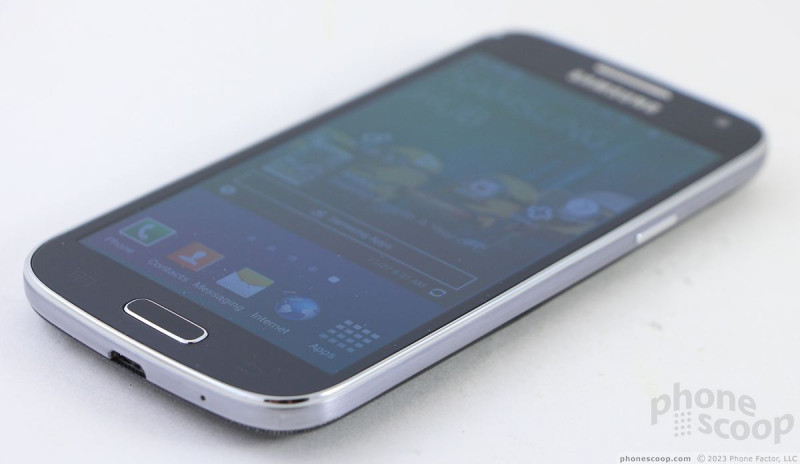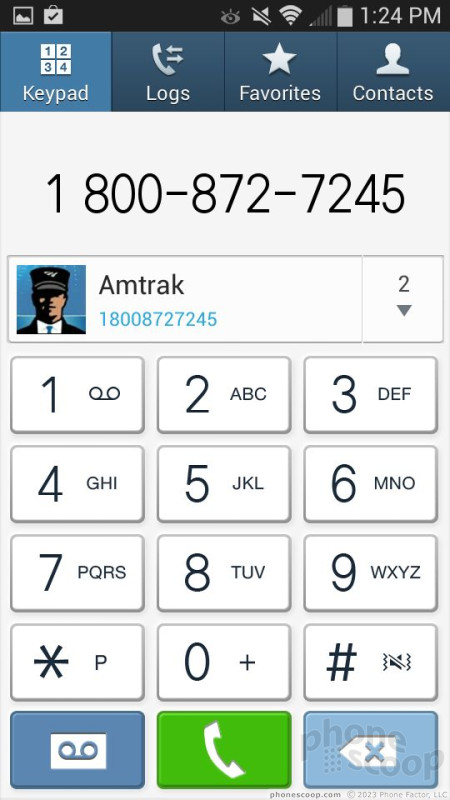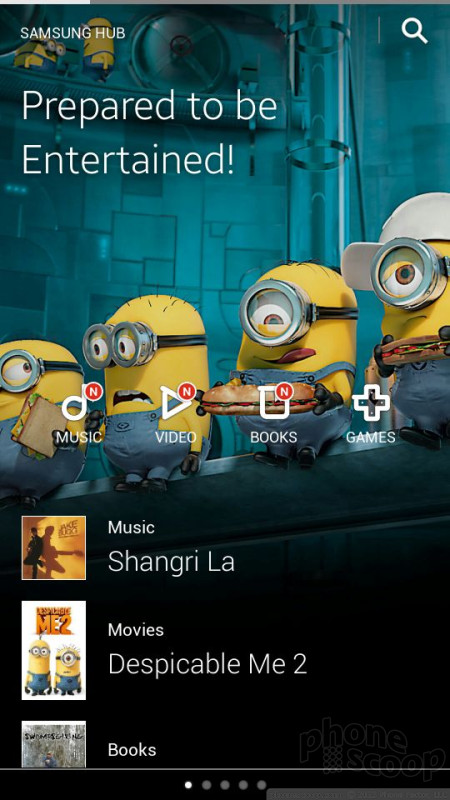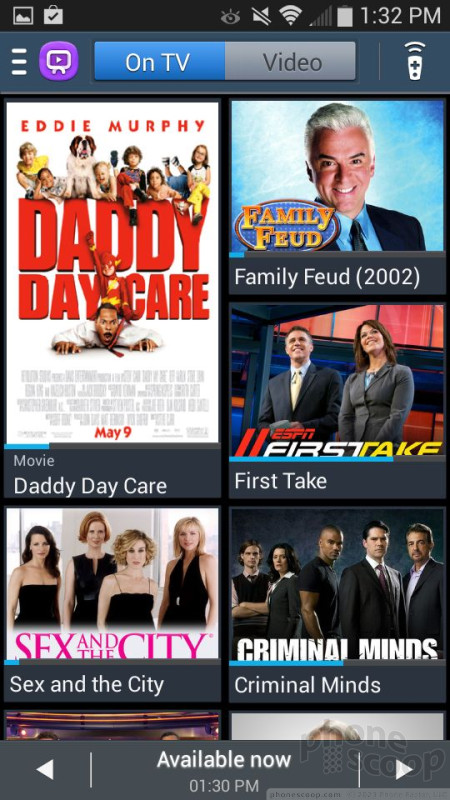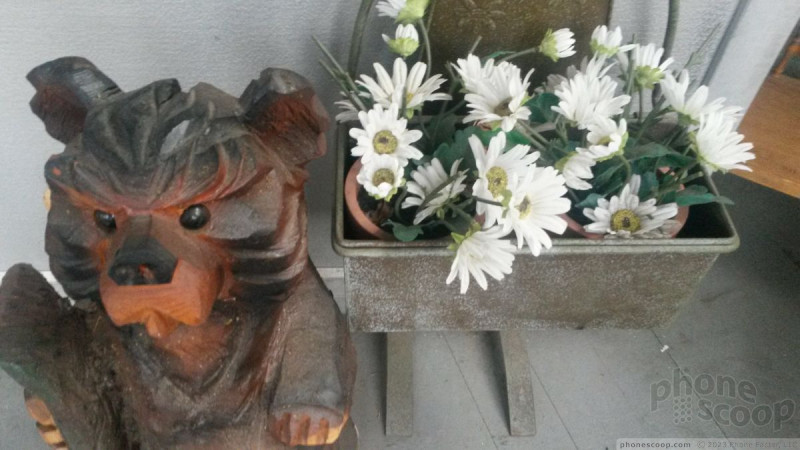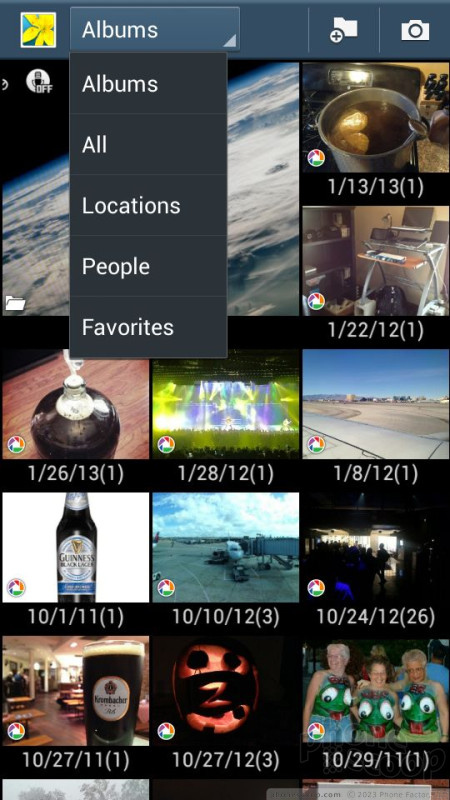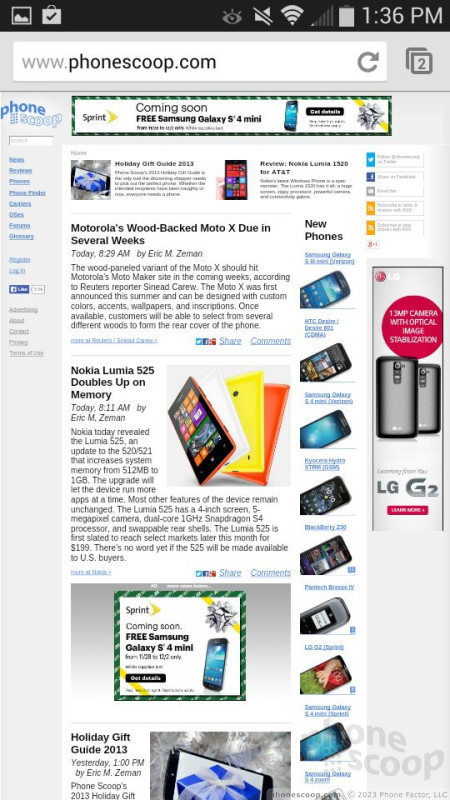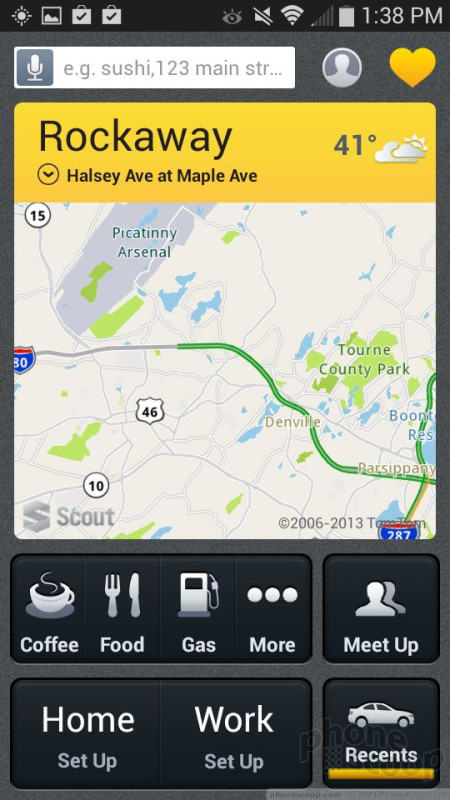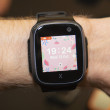Review: Samsung Galaxy S4 Mini for Sprint
Nov 27, 2013, 2:30 PM by Eric M. Zeman
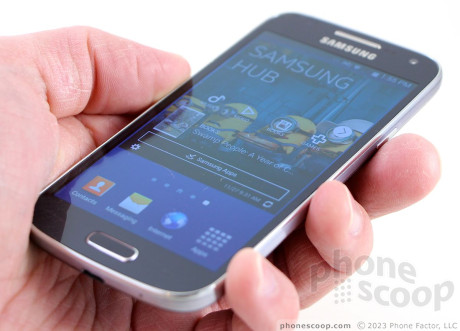
Samsung aimed a shrink ray at the venerable Galaxy S4 to create the GS4 Mini. This smaller smartphone doesn't offer quite the full GS4 experience, but it comes close enough.
Form
Is It Your Type?
The Mini is a smaller take on Samsung's Galaxy S4 flagship device. It doesn't pack quite the same punch as its larger brother, but it still offers plenty of bite in an easier-to-handle handset. If you like 'em small, the S4 Mini is an attractive alternative to today's behemoths.
Body
Samsung makes such a wide array of smartphones, it would be easy to mistake the Galaxy S4 Mini for any of the company's myriad smaller, less-expensive devices. It does bear some of the hallmark features of the larger GS4, however, that give it a bit more of a premium look.
For example, the GS4 Mini carries over my favorite design detail from the GS4: the metal-like band that encircles the edge. It's not actually made of metal, mind you (Samsung says it's polycarbonate,) but it passes for metal. This polycarbonate band is also incredibly strong, and lends the Mini a much-needed solid feel. There are other chrome elements, such as the grill covering the earpiece, and the rims that circle both the home button and the camera lens on the back, too.
The Mini has a textured look to the plastic that catches light and reveals a faux dimpled pattern when held at the certain angles. This design element is visible on the front and back, though more so on the back. The aren't actual dimples, it just looks like it. The whole device is wrapped in what looks like lacquer; it's glossy, smooth, reflective, and prone to collecting grossly apparent fingerprints.
The size is quite good. It's almost identical in dimensions to the Apple iPhone 5. That means holding it is comfortable and it fits snugly in the palm. It's lightweight and solid. It'll fit into just about any pocket with no problem. There's nothing cheap-feeling about it.
The Mini's face is clean and fits right in with the Samsung family of devices. The shape, the chrome, the accents, the physical home button, etc., are all clearly cut from the Samsung cloth. The screen itself is 4.3 inches and there are capacitive buttons on either side of the physical home key below the display. All of the buttons work well. The capacitive keys have good feedback and they light up for a short bit.
The volume toggle is a thin strip on the left edge of the phone. It has a good profile and is quite easy to find. Travel and feedback are excellent. The same is true of the screen lock button on the right edge of the phone. The headphone jack is on top and the microUSB port is on the bottom.
The battery cover makes up the entire rear panel of the phone. As with all Samsung devices, there's a notch that makes removing the cover a cinch. The Mini has a slot for both the memory card and the SIM card, but you have to remove the battery to access them. On the bright side, you can swap batteries if you need to.
It's a good little piece of hardware.
Performance
Screen
The GS4's display is one of its best assets. The same can't quite be said for the GS4 Mini. It dials down the size from 5 inches to 4.3, and the resolution from 1080p HD to qHD (960 x 540). I was hoping Samsung would have at least given the Mini a 720p HD display, but that's not the case. It's not a bad screen - not at all - but it's not the best, either. You can see pixels here and there and on-screen elements aren't as sharp as I'd like them to be, but the display is plenty bright and colorful. Viewing angles are excellent.
Signal
The Mini performed on par with other Sprint devices when it came to the network. It connected easily and held onto whatever signal was available. The Mini was able to connect calls under the worst network conditions, but managed to drop at least a few. When a strong signal was available, the Mini was a champ in terms of connecting calls and sending/receiving data. Speeds were never all that impressive, despite the fact that we tested the Mini on LTE. The Mini is one of the first tri-band LTE devices compatible with Sprint Spark, Sprint's jazzed-up 4G service. We tested the device in Manhattan, which is supposed to offer Spark access. As far as we can tell, however, the device didn't access Spark during our review period.
Sound
I was mostly pleased with the call quality when using the Mini. The earpiece produces rather sharp voices, but they are clear and audible under most circumstances thanks to the loud earpiece. I didn't have any trouble hearing callers in my home or when out and about, but the hissing of an espresso machine did its best to drown out one of my conversations. (The Mini supports HD Voice, but only when calling another HD Voice compatible phone. Both phones also must have access to LTE.) The speakerphone sounded a bit scratchy to me, and the volume wasn't as strong as it should be. People with whom I spoke said I sounded OK, but not great. Ringers and alerts are all fine in terms of volume, and the vibrate was plenty strong enough to get my attention.
Battery
The Mini has a 1,900 mAh battery inside, which is a bit smaller than the one in the full-sized GS4. The smaller screen doesn't need as much juice to keep it flowing, though, and the Mini is able to just get through a full day on a single charge. We tested it on LTE and that didn't seem to put much of a dent in the battery life. Most users should be able to get an entire waking day out of the Mini, but not much more than that. I'd charge it each night.
Basics
Menus
Once you move past the hardware, things start to become much more familiar. Like the larger GS4, the Mini runs Android with Samsung's TouchWiz user interface on top. It carries over the bulk of the GS4's insane number of apps, features, and capabilities.
The Mini starts with a customizable lock screen. You can choose to leave it simple, or add up five lock screen shortcuts plus a large digital clock. You can include a password, too, to keep the device secure, but you'll have to enter the code before using the lockscreen shortcuts. The camera is an exception to that rule.
The basic appearance of the home screen panels is essentially unchanged. There are five panels active out of the box, but that can be altered at will. They are stuffed with widgets for Samsung's apps, such as the Media Hub.
The notification shade lets you control tons of features. There are five toggles at the top that let you turn on/off various features. You can swipe these toggles to the left to gain access to more, as well as customize how they're arranged. You can also adjust the brightness from the notification tray, and of course see inbound notifications.
The main app menu is fairly customizable. Samsung allows users to see the apps in alphabetical or customized grids, in addition to an alphabetical list. Apps can be hidden or stuffed into folders, and tabs at the top of the screen let you quickly view which apps you downloaded, and what widgets are available.
As on other Samsung phones this year, the settings tools are broken into four separate screens: Connections, My Device, Accounts, and More. Obviously, the Connections tab is where you'll find controls for the wireless radios, Wi-Fi networks, NFC, S Beam, and so on. The My Device tab lets you adjust the wallpapers, ringtones, accessibility, gestures, and things of that nature. Personally, I don't like this setup. I'd prefer everything to be accessible from the same screen.
The Mini includes Samsung's Easy Mode, which reduces home screen clutter, drastically cuts down on menu confusion, and hides a lot of the MIni's features. This mode is meant for first-time smartphone owners who might be overwhelmed by the Mini.
One major feature the Mini lacks when compared to the full-sized GS4 is the split-screen multitasking mode. It doesn't make sense to include it, however, on a device with a 4.3-inch screen. It wouldn't be usable.
The Mini dials back on the horsepower a bit. It drops the quad-core 1.9 GHz Snapdragon 600 for a 1.7 GHz Snapdragon chip. It also loses 512 MB of RAM. Despite these downgrades, the Mini performs just fine. I didn't experience any trouble with it.
Calls/Contacts
The phone app offers all the customization powers from the GS4 that let you dig in and make the phone your own. When the dial pad is visible, tap the menu button and you'll see an options screen for the phone. Here is where you can set rejection behaviors, alerts, answering/ending calls, set up voicemail, and control the TTY functions. The basic calling tools are included, such as add a third line, send to Bluetooth, etc.
The contact app behaves more or less like the stock Android contact app. Favorites are accessible from a tab at the top of the phone app, as is the entire contact database. There are standard home screen shortcuts that let you direct dial and direct message your contacts, but there isn't a larger widget for your favorite contacts.
Messaging
The Mini has the typical list of messaging apps. The native communication tools include email, Gmail, Google+, and Google Hangouts, and they function perfectly on the Mini. I still find Google Hangouts to be a bit awkward for managing both SMS and IM conversations, though. Neither Facebook nor Twitter is pre-installed. Samsung's ChatOn messaging client is also absent.
Extras
Media
There are plenty of avenues you can take to find media content on the GS4 Mini. First, it includes all the usual Google Play apps and services. Google's content store has a good selection of music, movies, books, magazines, apps, and games from which to choose. The individual apps for enjoying that content all have the same user interface and work well.
The Samsung Hub - Samsung's own media store - is also available. The Hub is not as well organized as the Play Store, nor does it have as good a selection, but prices are consistent between the two. Don't worry, Samsung didn't forget to include WatchOn, its video content discovery and remote control app. WatchOn lets you find out what's on your TV, and then use the built-in infrared port to turn on the TV. (In-depth descriptions of these features are available in our review of the full-sized Galaxy S4 here.)
The Mini also includes the bare-bones MP3 and video player apps, as well as the stock YouTube app. These are your best options if you choose to listen to music or watch videos you've stored on a memory card. There's a CBS Sports app, which lets you check scores, read news, and watch highlight clips. The Mini also has NextRadio, which is an internet-based streaming radio service.
Last, if you think these aren't enough, Sprint Music Plus and Sprint TV & Movies are both installed on the Sprint version, as well.
If you want to share your media, you can so with the Group Play feature, which lets one person with modern TouchWiz device (GS4, Note 3, GS4 Mini) play some music and have the other devices connect to and stream the same song at the same time. Then there's Samsung Link, which can be used to connects the Mini to other DLNA-compatible devices for wirelessly playing back more types of media.
Camera
The GS4 Mini carries over nearly all the great camera features from its larger brother. There's no dedicated camera button, but the camera can be launched from the lock screen. The camera is the only app that will bypass a password. The app opens quickly enough.
The controls are all laid out plainly enough. There's no longer a "camera mode" and "video mode." Instead, the Mini has both a camera button and video camera button on the right side of the screen at all times. This way, either media type can be captured without first requiring the user to swap modes. The other benefit of this setup is that you can capture stills while also recording video.
There's a button for switching to the user-facing camera and a button to open the full settings menu. Pressing the settings button first opens an expanded view of the control strip, with more options (flash, microphone mute, night shot). These can be customized if you wish. As usual, owners can fine-tune most aspects of the camera software (pixels, aspect ratio, white balance, exposure, etc.).
The Mini has 12 different “modes” for capturing images, and there are two ways to interact with them. Press the mode button (below the shutter) and you'll see a carousel view of the different modes with a detailed explanation of each mode and what it produces. You can spin through the carousel options quickly to find the mode you're looking for. Alternately, there's a button on the left side of the screen that lets you see all the modes laid out in a visual grid. This grid layout is a faster way to access the shooting modes once you're familiar with the way they operate. The modes include auto, sports, night, panorama, burst, HDR, Beauty Face, Best Photo, Best Face, and Sound & Shot. It drops three options from the GS4: Drama Shot, Animated Shot, and Eraser Shot. The Mini also drops the ability to use the rear- and front-facing cameras at the same time, which is shame. (In-depth descriptions of these features are available in our review of the full-sized Galaxy S4 here.)
Not only are these camera features fun to use, they're pretty easy to use. It takes less than 5 minutes to learn how to use them all, and they open up a wide range of creative possibilities.
Photos
The Mini has an 8-megapixel camera. In general, I was pleased with the results. Images were consistently in focus, well exposed, and had accurate white balance. I didn't see any grain problems, or issues with imbalanced lighting. Indoor performance, especially at night, wasn't the best, but using the flash helps a lot. Of course, using the Mini outdoors under a sunny sky produces the best results, but the creative powers of the Mini mean you can produce artistic results even on the grayest of days. If you really want action shots to turn out, you need to use sport or burst modes (the auto setting is a bit slow for action scenes). Most people will be happy with the images they get from the Mini.
Video
The Mini's ability to record video was also consistently good. Things such as color, focus, and exposure were almost always spot on. The clarity of the 1080p video I captured was exceptional at times. The Mini can surely record video worth sharing with family this holiday season on your HDTV.
Gallery
The Mini uses the stock Android gallery software. The device will automatically sync images from your Google+ and Dropbox accounts, but you can thankfully turn these off. There's a drop-down menu accessible from a button at the top of the screen for sorting between albums.
When you dive down into the individual galleries, the Mini goes into a split-screen mode: a vertical list of other galleries forms a strip along the left edge of the screen, and the rest is reserved to show larger thumbnails of the images in the gallery you chose to view. Editing options are limited to the standard crop, rotate, reduce red-eye, or apply a handful of filters to account for lighting, exposure, color, and so on.
The Mini also has the new Google+ Photos app. This app only interacts with the photos that are stored in (and auto-uploaded to) your Google+ account. You can share them online, as well as make some edits to them, including Google's new Auto Awesome features. For example, the Google+ Photos app can automatically create GIFs from a collection of sequential, related photos.
Story Album
Story Album is an app that lets you create photo albums. The app is separate from the gallery or camera apps, but it pulls images from the gallery. It can automatically create albums for you based on date or location, or cede full control to the artiste in you. The tools are easy to figure out and the Mini walks you through the process. Story Album offers a handful of themes and layout configurations, you can manually manipulate photos, add captions, and more. Once you've put albums together, you can export them as PDFs for printing or sharing, as well as order an actual photo album that is professionally printed and delivered via mail.
Apps
The Mini comes chock full of Samsung apps and services, but loses some of the GS4's coolest features. For example, the Mini lacks Air View and Air Gesture, Smart Scroll and Smart Stay, the Optical Reader and S Health. What you will find are S Memo, S Translator, and S Voice, as well as the Samsung App Store. There are more than 60 apps pre-installed thanks to a wide range of junk from Sprint. That said, there's still plenty of room left over for users to download and install their own apps.
Bluetooth
I had no trouble connecting the Mini to a variety of Bluetooth devices (laptop, smartphones, headsets, etc.). Discovery and setup was a snap thanks to Samsung's on-screen prompts. The quality of phone calls passed through a mono headset was good, but not great. The same is true of music sent to a set of wireless speakers.
Browser
The Mini ships with both Chrome and the generic Android browser on board. Both are fine tools for browsing the web and do a good job of rendering HTML web sites. Chrome offers more features in that it can be synced with the desktop version of Chrome, but the generic Android browser offers simpler controls. Neither was particularly quick on Sprint's LTE network, though.
Clock
If you're serious about checking the time from the Mini's lock screen, I suggest you enable the lock screen shortcuts and select one of the clocks available there. The basic clock that appears on the lock screens by default is too small to see easily. The other clocks are better.
GPS
The Mini includes Google Maps and TeleNav's free Scout navigation application. Google Maps works the same as on any other Android devices. Scout is a quirky little application that covers the navigation basics (routing, planning, auto-sent ETA messages, etc.). Both interacted with the Mini's GPS hardware without issue. The Mini was very quick to pinpoint my location to within about 25 feet most of the time.
NFC
The Mini includes an NFC radio, which can be used for a handful of different actions. For starters, it can be used with similarly-equipped Bluetooth devices for easy pairing. It can also be used with Samsung's SmartTags, which are programmable NFC stickers. These let you do things like tap the sticker to turn on/off the Wi-Fi radio, or check into a specific location on Foursquare. The Mini will run Google Wallet, and I was able to set the app up to make mobile payments.
Wrap-Up
The Samsung Galaxy S4 Mini comes close to providing the full GS4 experience in a smaller package, but there are some notable omissions.
The biggest disappointment to me is the screen. I understand that Samsung needed to reduce the size in order to shrink the phone's footprint, but it dialed the resolution back to 2011. The rest of the hardware looks good and functions well. Voice calls are generally good, signal performance was adequate, and battery life delivers a day's worth of use.
The software is nearly as advanced as the full-sized phone, but nixes some of the features for reasons unknown. For example, Smart Stay and Smart Scroll are gone, but you can still use Face Unlock. The TouchWiz user interface is as flexible (and complex) as ever. The camera offers plenty of neat features, but loses the GS4's most exciting capture modes. Thank goodness the Mini takes good pictures. Media options are plentiful, even though the GS4 Mini doesn't have the best screen on which to watch movies.
Sprint is selling the Galaxy S4 Mini for $100 with a new contract. That's a fair price for what you get: a smaller, more user-friendly handset that isn't quite the flagship it pretends to be.
Comments
What about the notification light?
If so, that detail should definitely be stated in the review.
"On the bright side, you can swap batteries if you need to"
While my friend's HTC One is still under defect warranty, he could've easily spent up to $175 deductable if the battery had died outside the warranty. He asked me who's bright idea it was to seal the battery? He has been playing tether with an electrical outlet for the last two months.
I really hope this trend is just a pie throwing contest with manufacturers. People are slowly seeing my point that when you pay good money for a device, it shouldn't have the potential to be rendered useless due to a failed battery.
I'm on a quest to litter the web with this argument. So, excuse my continued rant.
John B.
I too aim to make people understand that a sealed battery is not a good idea. Even less for a "premium" device.
Though it will be extremely difficult to make manufacturers/carriers change this due to the profit t...
(continues)
(continues)


